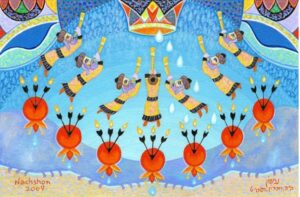בס”ד
By Rabbi Moshe Goodman, Kollel Ohr Shlomo, Hebron

This parsha discusses the place of the king in Judaism. Obviously the human king carries implications on
understanding the description of one of Hashem’s attributes [obviously not His Essence] as king, as we
use this description extensively in the coming days of Awe between Rosh Hashana and Yom Kippur.
Yet again we see the seven pomegranates, seven shin’s upon them, and seven hasidim above them each
blowing a shofar, the special Jewish number, constantly seen in R’ Nachshon’s paintings. We also see
seven drops of water as if descending from the Crown. These four aspects of seven seem to correlate to
the four letters of the Tetragrammaton/four worlds. The drops of water represent emanating from the
“Divine Crown” represent the world of Emanation/Atzilut which is also associated with kindness and the
theme of water. The hasidim blowing the shofar, the instrument of repentance, represent the world of
Briah associated with repentance. The shins have three prongs resembling the letter vav, and this
corresponds to the vav in the Tetragrammaton, associated with the world of Yetzira. The pomegranates are
red-colored, a color associated by the Kabbalists to the attribute of judgment, which is also the attribute of
the world of Asiah. In addition, pomegaranates grow from [a tree upon] the earth, which is also associated
to Asiah. The pomegranates have petals that resemble crowns turned up-side down perhaps hinting to a
Kabbalisit idea that links between the highest sefira Keter to the lowest sefira malchut associated with
Asiah, in an idea called “Keter Malchut,” literally meaning the “crown of kingship.” Underneath these
pomegranates drops of water, a symbol of kindness as mentioned. Indeed, the Kabbalists call the malchut
sefira, the “daughter of kindness.”
There are 24 protrusions in the wall underneath the pomegranates which may hint to the 24 Divine courts,
and the verdict of judgment that is sweetened through the process of repentance, prayer, and kindness of
charity, hinted by the drops, seen in this painting. Three judges are used in the Jewish court. How great is
the merit of those attached to the three holy righteous “judges” of Hebron, the holy Patriarchs!



